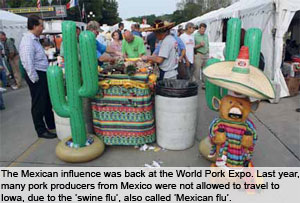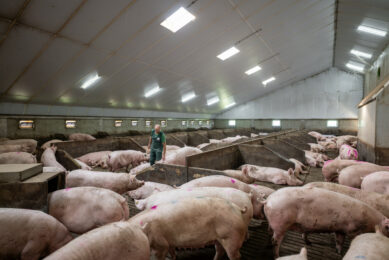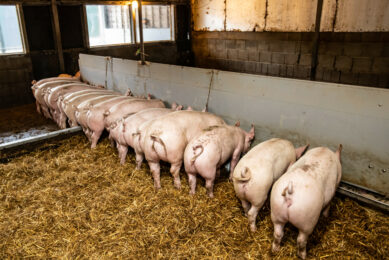A touch of fiesta at the 2010 World Pork Expo

For several years, there was no reason to smile in the United States. High feed prices, low hog prices, export slums and H1N1 kept American pig production in the red figures for quite some time. This year, everything was different. It was a new dawn – and the return of black figures were greeted with broad grins and barbecues.
By Vincent ter Beek
No misunderstanding – the atmosphere at this year’s World Pork Expo (9-11 June) was far from being complacent. When only listening to the US’ National Pork Producers Council (NPPC), one would conclude that a lot of things in the American pork production industry seriously require a lot of attention. Once more, the council heavily resisted legislation that would clamp down the use of antibiotics and also encouraged US Congress to make haste with approving the US-Korea Free Trade Agreement. More about these issues later on in this article.
Far away from the media centre, however, completely different sounds could be heard. It was the talking, the chatting, the informing – it was a buzz, signifying optimism – and to top it all, it happened in Spanish as well as in English. After one year of absence due to the H1N1 crisis, Mexican pig farmers returned to Iowa. Their presence confirmed the international status of the World Pork Expo – being especially strong in the Americas.
According to the World Pork Expo organisation more than 20,000 producers and 400 exhibitors celebrated the pork industry’s return to profitability during the event which was held in Des Moines, Iowa. Last year, the show attracted 14,625 visitors – down over 3,000 from the 17,756 attendance in 2008. More than 30 countries were represented at the 2010 World Pork Expo.
“The mood has just been great,” summarised NPPC president Sam Carney after the show. “Producers are excited, exhibitors are upbeat and the industry is back on track.” Economist Steve Meyer had already confirmed there was reason for applause in his market update. He said it was difficult to say how much money US producers had been making as the black figures had only returned months before the WPX.
Exports
One of the reasons the US pork industry has started making money again is related to the return of the exporting opportunities. Last year, because of the closing of the Chinese and Russian markets for US meat due to H1N1 outbreaks, export figures dropped severely. In 2009, a NPPC press release revealed, the USA exported a total of 1.86 million metric tonnes of pork, valued at $4.32 billion, equalling a decrease of 9% in volume and 11% in value for exports in 2009. Trade to Mexico and the Philippines, however, grew throughout 2009 which gives the experts reason to believe better times are ahead.
The NPPC were quick to point out that a further development of Free Trade Agreements are a must to safeguard the presence of the US on a world pork stage. A calculation by Iowa State University professor Dermot Hayes once more emphasised the role of FTAs for the US pork industry. “The market access generated through the Uruguay round, the NAFTA, and other trade agreements has been the major catalyst in the expansion of US pork exports. In addition, the weakening of the US dollar coupled with excellent US herd health status and recent dramatic increases in US sow productivity have combined to provide the industry with a significant competitive advantage over all other international suppliers. As the world recovers from the recent economic crisis, consumers throughout the world will renew a trend towards additional meat consumption. It is far more efficient for food importing countries to import the finished meat products than it is to import the grain needed to produce meat domestically. This means that the potential for additional exports in the short to medium term is enormous.He continued to say: “To achieve its export potential, the US pork industry must maintain access to important customers such as China and Russia and expand market access in markets such as South Korea, Colombia and Panama. This latter group of countries has agreed to eliminate tariffs on US pork and other products in the context of FTAs negotiated with the United States.”
| The antibiotics issue The general outlook in the USA towards the use of antibiotics in livestock production strongly differs from the point of view that is taken in the European Union nowadays. Where the European Commission banned the use of antibiotic growth promoters back in 2007, with even stricter legislation being discussed in some countries, in the USA this tendency is felt to be overcautious, not to say ‘paranoid’. A strong opposition from the US National Pork Producers Council (NPPC) could therefore be heard at this year’s World Pork Expo towards two bills which, if they are passed, may imply the limitation of antibiotic use in the US as well. One piece of legislation that could pass Congress is the Preservation of Antibiotics for Medical Treatment Act – or PAMTA, which would limit the use in food animal production of seven classes of antibiotics. At an NPPC press conference, Dr Howard Hill, DVM, from Iowa Select Farms, said: “There is no defending science linking antibiotics to resistance in animals. The NPPC supports the responsible use of antibiotics. I don’t think US producers have a rogue use of antibiotics – they are conscientious of a very careful use.” Hill noted that there are four ways in which antibiotics can be used – as treatment, control, prevention or as a growth promoter. Moderate opponents refer to banning the use of only the latter, stricter opponents like to see a total ban. He said, “When used as a growth promoter, there is less than a teaspoon used in a tonne of feed. Taking into account the withdrawal time, there is no antibiotic left in the pig at slaughter.” He continued to say that “decisions and regulations should be based on transparent risk analysis – not on emotions.” The NPPC is usually quick to refer to Danish data indicating that after the ban on antimicrobial growth promoters in Denmark, pork producers ‘saw a rise in piglet deaths and a 110% increase in the antibiotics used to treat animal diseases’. Hill added: “Trying to control and prevent it is a lot better than to treat it, as then you will have to use antibiotics at a much higher level. To me, it seems counterproductive to remove antibiotics.” |
South Korea
Especially the continuous pending of approval of the free trade deal with South Korea has been frustrating for many pork producers in the USA. The deal was signed on 30 June 2007 and will immediately lift some 85% of each nation’s tariffs on industrial goods, and also create new protections for multinational financial services and other firms. It’s not difficult to underestimate the consequences of this FTA as it is the US’ first free trade deal with a major Asian economy, and its largest trade deal since the NAFTA in 1993. Still, it has not yet been approved by Congress as opinions are divided about the deal’s contents, e.g. the consequences for the automobile industry.
South Korea on the other hand, have struck trade deals with Chile, Singapore, the Association of South East Asian Nations (Asean) and the EU. This last trade deal still has to be approved by the EU as well but since Brussels is making progress with this, the NPPC has started to become anxious. Quoting Hayes again, who has been projecting that the US would be eliminated from the Korean market over a ten-year period, the NPPC once more encouraged US Congress to move on. “Losing the Korean market means losing thousands of US jobs. This is not an option. For the US pork industry to remain successful and viable, we need new and expanded market access, and the way to get that is through FTAs.”By the time dawn breaks for the next World Pork Expo, on 8 June 2011, the South Korea issue may have already been resolved. For US producers, it may prove to be a vital help to continue being in the black figures.











